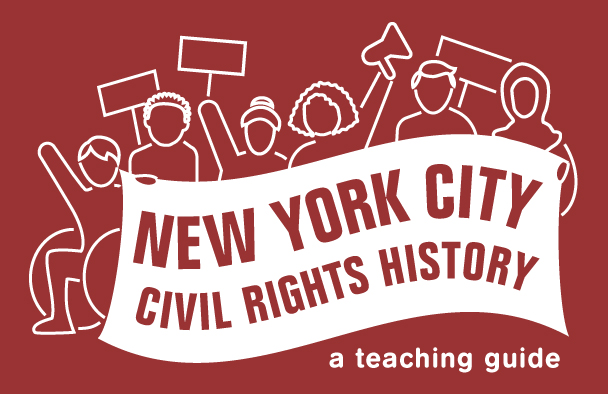- Segregation contributes to educational inequality in New York City.
Segregation means setting one group or category of people physically apart from others. Segregation can happen across large or small spaces. Segregation on a large scale, for example, includes a housing development occupied only by Black or white people, or a section of town occupied only by Latinx people. Segregation on a small scale, for example, can be when Disabled students are in one classroom and non-Disabled students are in another within the same school.
Segregation is one way that people in powerful positions have used their power for their own interests. Throughout NYC’s history, white, wealthier, and non-disabled people have created and maintained segregation to concentrate resources and opportunity in the hands of white, wealthier, and non-disabled students while denying them to students of color, Disabled students, and poor students.1 This inequality takes a wide range of forms, including access to classroom materials, safe and secure school buildings, and enrichment opportunities by highly skilled teachers. This inequality is often most severe for people who experience segregation by both race and disability.2
For Disabled students, needed services and resources are often only available in segregated spaces. Specific accommodations or supports may only be available in schools or classrooms away from students’ non-disabled peers. While disability law calls for Disabled students to spend as much time as possible with non-disabled peers, many special education programs involve pulling students out of class, or even moving from one school to another, for their education and accommodations. 3
Some activists for educational justice in NYC have always been concerned that segregation denies students opportunities to get to know one another and learn together across different life experiences. Most educational justice activists agree that, in the context of racism and ableism, school segregation has contributed to unequal educational resources and opportunities. Historically marginalized people not only experience segregation and inequality as a lack of needed resources, but also as a lack of power to determine what happens within segregated spaces.4
Despite these challenges linked to segregation, some Black and Latinx communities and some disability communities have created strong schools and/or learning spaces for themselves.5
-
Christopher Bonastia, The Battle Nearer to Home: The Persistence of School Segregation in New York City (Palo Alto: Stanford University Press, 2022); Kimberly Johnson, “Wadleigh High School: The Price of Segregation” in Educating Harlem: A Century of Schooling and Resistance in a Black Community, ed. Ansley T. Erickson and Ernest Morrell (Columbia University Press, 2019), 77-100, https://ansleyerickson.github.io/book/chapters/03/; Mark Winston-Griffith and Max Friedman, Season 1, 2019, in School Colors, produced by Brooklyn Deep, podcast, https://www.schoolcolorspodcast.com/brooklyn. ↩︎
-
Cheri Fancsali, “Special Education in New York City: Understanding the Landscape” (Research Alliance for NYC Schools at NYU Steinhardt, 2019), https://steinhardt.nyu.edu/research-alliance/research/publications/special-education-new-york-city; Francine Almash, “New York City ‘600’ Schools and the Legacy of Segregation in Special Education,” The Gotham Center for New York City History, June 21, 2022, https://www.gothamcenter.org/blog/new-york-city-600-schools-and-the-legacy-of-segregation-in-special-education; Emily B. Clark, “Deserving to Belong: Complex Narratives of Working and Learning in Self-Contained Spaces” (Ph.D diss, CUNY Graduate Center, 2021); José P. v. Mills, https://www.advocatesforchildren.org/litigation/class_actions/jose_p_vs_mills; Lora v. Board of Educ. of City of New York, 587 F. Supp. 1572 (E.D.N.Y. 1984. https://law.justia.com/cases/federal/district-courts/FSupp/587/1572/1752714/.; James Haskins, Diary of a Harlem Schoolteacher (New York: Grove Press, 1969). ↩︎
-
Fancsali, “Special Education”; Individuals with Disabilities Education Act, 1990, https://sites.ed.gov/idea/statute-chapter-33/subchapter-ii/1412/a/5 ↩︎
-
Marta Gutman, “Intermediate School 201: Race, Space, and Modern Architecture in Harlem,” and Russell Rickford, “Black Power as Educational Renaissance,” in Erickson and Morrell, Educating Harlem; Winston-Griffith and Friedman, School Colors; Barbara Ransby, Ella Baker and the Black Freedom Movement: A Radical Democratic Vision (Chapel Hill: University of North Carolina Press, 2003). ↩︎
-
Heather Lewis, New York City Public Schools from Brownsville to Bloomberg: Community Control and its Legacy (New York: Teachers College Press, 2015); Deidre Flowers, “A School for Modern Times: Mildred Louise Johnson and the Founding of the Modern School of Harlem,” Journal of African American History 105, no. 4; Crip Camp, directed by James Lebrecht and Nicole Newnham (2020; Rock Hill, NY: James Lebrecht, Nicole Newnham, and Sara Bolder), netflix.com; Winston-Griffith and Friedman, Season 1, School Colors; Deaf Social Spaces ↩︎
